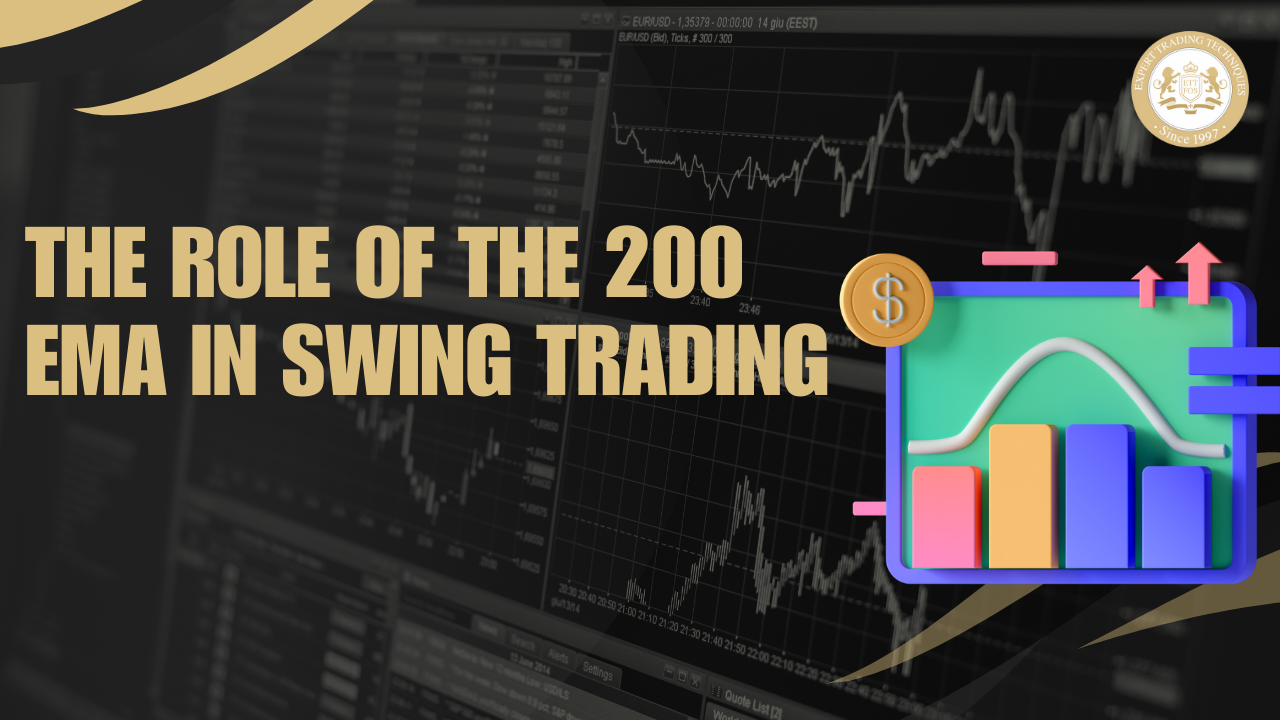
The 200 Exponential Moving Average (EMA) is a crucial tool in swing trading, helping traders understand the overall trend direction. It’s calculated by averaging the closing prices of a stock or currency pair over the last 200 periods, with more weight given to recent prices. Traders rely on the 200 EMA to spot long-term trends and potential turning points in the market.
Traders often use the 200 EMA as a guide to determine when to enter or exit trades. When the price is above the 200 EMA, it’s seen as a bullish signal, suggesting an uptrend. Conversely, when the price is below the 200 EMA, it indicates a bearish trend or potential reversal. Understanding these dynamics can help traders make more informed decisions and improve their overall trading performance. So in this blog, we’ll explain the importance of the 200 EMA in swing trading and provide practical tips on how to use it effectively.
The 200 Exponential Moving Average (EMA) is a popular indicator used by traders to gauge the overall trend of the market. It is calculated by averaging the closing prices of an asset over the last 200 periods, giving more weight to recent prices.
Traders often use the 200 EMA to determine the direction of the trend. If the market price is above the 200 EMA, it is considered an uptrend, indicating that prices have been increasing over the long term. On the other hand, if the market price is below the 200 EMA, it is considered a downtrend, suggesting that prices have been decreasing over the long term.
For example, let’s say the price of a stock is trading above its 200 EMA. This could indicate that the stock is in an uptrend, as the average price over the last 200 periods is higher than the current price. Traders may interpret this as a bullish signal and look for buying opportunities.
Conversely, if the price of a stock is trading below its 200 EMA, it could suggest that the stock is in a downtrend. Traders may see this as a bearish signal and consider selling or shorting the stock.
The 200 EMA is not only used to identify trends but also to determine potential entry and exit points for trades. Many traders use the 200 EMA as a reference point for placing stop-loss orders to manage risk. If a stock is in an uptrend and trading above its 200 EMA, traders may place a stop-loss order below the 200 EMA to protect their profits in case the trend reverses.
Using the 200 Exponential Moving Average (EMA) in swing trading can give you valuable insights and confirm trends. One way to use it is to confirm the trend direction. When the price is above the 200 EMA, it suggests an uptrend, and when it’s below, it indicates a downtrend. Traders often look for buy signals when the price crosses above the 200 EMA in an uptrend or sell signals when it crosses below in a downtrend.
Another way to use the 200 EMA is to find potential support and resistance levels. During an uptrend, the 200 EMA may act as support, while during a downtrend, it may act as resistance. Traders can look for opportunities to enter trades near the 200 EMA with the expectation that it will continue to act as support or resistance.
200 EMA can also help identify potential trend reversals. For example, if the price has been trading above the 200 EMA in an uptrend and then crosses below it, it could signal a potential trend reversal to the downside. Similarly, if the price has been trading below the 200 EMA in a downtrend and then crosses above it, it could indicate a potential reversal to the upside. Traders can use these signals to adjust their trading strategies and manage their trades more effectively.
As you can see, Microsoft stock took support at the 200 EMA, indicating a potential reversal from the downtrend. This signal becomes more powerful when combined with other confirmations, such as Fibonacci retracement levels. For instance, if the stock bounces off the 200 EMA and also retraces to a key Fibonacci level, like the 50% or 61.8% level, it provides a strong buying opportunity. In this scenario, you could consider going long on Microsoft stock with a stop-loss below the recent swing low to manage risk effectively
Combine with Other Indicators: Don’t rely solely on the 200 EMA. Look for confirmation from other indicators like volume or chart patterns. For instance, if a stock bounces off the 200 EMA and breaks out with increasing volume, it could signal a strong trend.
Maintain a Watchlist: Keep an eye on stocks nearing or reacting to the 200 EMA. This helps you spot potential trade opportunities without constantly watching the markets.
Set Price Alerts: Set alerts for when stocks reach the 200 EMA. This way, you’ll be notified when a stock is at a key level, allowing you to make timely trading decisions.
Use Stop Loss Orders: Place stop-loss orders just below the 200 EMA for long trades and just above it for short trades. This helps you manage risk by limiting potential losses.
In this article, we’ve explored the crucial role of the 200 Exponential Moving Average (EMA) in swing trading. The 200 EMA serves as a powerful indicator for identifying trends and potential trade setups. By understanding how to effectively use the 200 EMA in your trading strategy, you can improve your chances of success in the market. We hope this discussion has provided you with valuable insights into how you can integrate the 200 EMA into your trading approach.
Also Read: Most Common Mistakes Traders Make and How to Avoid Them